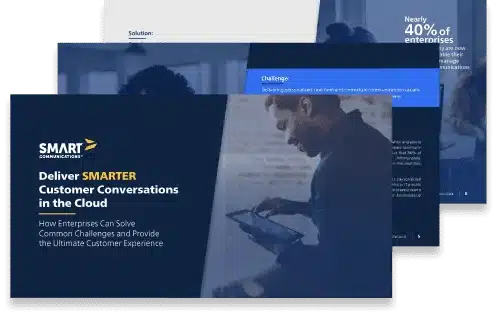The Future of Personalization in Insurance Claims
By: Ruth Fisk, VP Insurance Marketing at Smart Communications
Customers today have sky-high expectations. They expect to be able to do whatever they need digitally and expect around-the-clock access to services from any device. And they expect ease, speed and personalization in every digital experience—not just when it comes to online shopping or ordering food. Now more than ever, consumers want the same simplicity and on-demand availability they’ve become accustomed to with delivery services and similar apps in all aspects of their lives.
For insurers, this means radically transforming processes that have traditionally been manual and paper-based. As new players enter the field, providers need to catch up to the latest digital capabilities or risk losing market share. That’s why insurers are prioritizing overall efficiency, faster settlements and reduced policyholder effort. As part of this effort to become more efficient and effective, insurance leaders are focusing on one of the most common pain points: claims management.
Smart Communications, in partnership with Salesforce and Insurance Innovators, recently conducted a survey of more than 150 insurance executives and found that 95% agree that the claims experience is where insurers have the greatest opportunity to win loyalty—but also the greatest risk of losing it. In this post, we’ll take a deep dive into this new research and look at how insurers can:
- Use personalization to reimagine the claims process for today’s consumer needs and priorities
- Build brand trust and loyalty
- Get to know their customers better
- Drive long-term growth
All of the information below is from the report Hyper-personalization in Claims: Streamlining Processes to Build Loyalty and Trust, produced in partnership with Salesforce and Insurance Innovators.
The Current State of Personalization in Insurance Claims
Previously, filing an insurance claim meant a lot of forms and hassle. While the insurance industry has been on a somewhat slower digital transformation trajectory compared to other industries like retail or banking, recent world events threw that arc into overdrive.
When the global pandemic struck, sweeping stay-at-home orders brought about transformative change to countless activities, from how we work to how we get food. Suddenly, people were doing everything digitally — holding virtual meetings, doing mobile banking, even ordering groceries online and having them delivered right to their door.
Meeting consumer expectations is at the forefront of every claims manager’s mind, especially while insurers seek to exceed their claimants’ expectations — while still balancing the need to effectively investigate and settle claims. To do so, the claims experience requires digital solutions to support hyper-personalization and two-way customer conversations, while also providing easy-to-use interfaces and seamlessly delivering information across customers’ preferred channels and devices.
The increased exposure to digital services in the past two years has broadly impacted consumer expectations. And insurers recognize this—85% believe that the level of live interaction customers experience with home deliveries has set a new benchmark for the insurance claims experience. Poor experiences include paper-based forms, tedious processes and having to repeatedly enter the same information. In a highly competitive market, just one bad experience can cost the loss of that customer’s business for life.
Insurers need to level up to meet these new expectations. Keep in mind, insurance interactions will be measured against the customer’s last best digital experience. That means insurers are being compared with big brands such as Amazon, Netflix and Instacart which calls for radical change. The good news is that change is definitely possible through the use of Artificial Intelligence (AI) which can enable insurers to better align their processes and software to meet customers’ growing expectations. Even better, the data below shows that (at least some) insurers are catching on:
Insurer AI expectations by end of 2023:
- 88% will pre-populate FNOL forms
- 83% will tailor scripts
- 70% will adapt forms in real time
- 67% will allow channel shifting
- 43% will use AI for omnichannel orchestration
There’s a real opportunity for insurers to meet the moment and rethink outdated processes. In addition to simplifying claims, protecting valuable customer data is also critical in today’s digital world. Not only are paper forms inefficient, but they also put sensitive data at risk. Digitizing forms helps improve processes and protect customer data, which enables straight-through processing to allow for faster claims.
Hyper-personalization: The Future of Insurance
According to our survey, insurers currently have three top claim-related priorities: significantly reducing time-to-decision, building trust with claimants and improving customer loyalty.
The industry believes hyper-personalization will result in:
- Increased efficiency (89%)
- Faster settlement times (84%)
- Deeper trust and loyalty (94%)
To deliver on all three goals, insurers will need to adopt modern technology platforms that can help them personalize customer conversations. This means pulling customer data into digital forms to save time and hassle and making the relevant forms, processes and information available around the clock.
It’s no longer enough to add digital experiences to a website. Today’s customers expect to engage across channels—from mobile apps to social media. And to switch channels when needed, without having to start over. Taking advantage of sophisticated technology solutions allows insurers to meet customers where they are.
The research found that 83% of insurers agree that their ability to shift channels with customer needs and circumstances is a key factor in deepening trust and loyalty. Insurers can exceed expectations by providing seamless cross-channel experiences, which allow policyholders to fit interactions into their day without disruption. For example, they should be able to start a claim on a mobile app and follow up via web chat without losing the thread or having to answer the same questions again.
How Automation Can Help Insurers Meet the Moment
To meet today’s customer expectations, insurers need to focus on creating the kind of digital interactions that build trust and loyalty. They need to simplify and streamline processes, reducing the hassle factor when it comes to filing and managing claims. To drive the kind of customer satisfaction and retention that leads to long-term revenue growth, it’s time to bring hyper-personalization into the picture.
Hyper-personalization is about pairing customer data with automation to tailor communications and experiences individually, and at scale. Pulling existing customer data into AI-powered smart forms reduces customer effort—a common claims pain point. And by streamlining FNOL interactions as well as status updates, decisions and settlements can be made faster.
Where claims handlers have traditionally spent significant time asking questions and collecting information, automation can now do the work instead. This saves time on both sides and frees up staff to provide personal support for the more complex, high-value cases when a human touch is really needed. Plus, customizing conversations makes the whole experience more personal, so customers feel seen and appreciated—a key component of building brand loyalty.
In the realm of insurance claims, hyper-personalizing customer conversations significantly increases end-to-end efficiency, resulting in a higher quality and more satisfying experience for the claimant.
Change the Conversation with Cloud Technology
The best way to deliver hyper-personalization in claims is for insurers to invest in and adopt a cloud-first strategy that focuses on optimizing the end-to-end customer experience. The Conversation Cloud helps insurers move beyond paper-based processes to implement a digital-first strategy at scale, optimize the end-to-end customer experience and make every interaction SMARTER.
The right digital platform works seamlessly with core systems including claims management tools — giving insurers a way to turn one-way, transactional messages into two-way, interactive conversations. Insurers can then put existing customer data to use and enjoy frictionless experiences when collecting new data. And with an omnichannel approach, it’s easy to meet customers where they are on their preferred channels and devices — bringing the convenience they expect into the insurance experience, too.
Investing in a solution that enables insurers to provide personalized claims experiences yields measurable returns, including:
- 89% increased efficiency
- 74% reduction in settlement time
- 74% reduction in customer effort
—
To take a deeper dive into the information shared in this blog post, check out Hyper-personalization in Claims: Streamlining Processes to Build Loyalty and Trust, an infographic produced in collaboration with Salesforce and Insurance Innovators.



